Genre
Genres are different types of video games classified by gameplay. With over 200 entries, the Mario series has included a variety of different genres. Some games such as Super Paper Mario and Mario Super Sluggers belong to multiple genres. The oldest Mario games started out as platformers, but with the introduction of the Super Nintendo and Nintendo 64, many new genres of Mario games were created.
Types of Genres
Platform
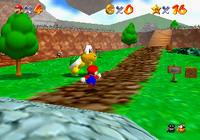
Platform games consist of going through levels to reach a goal. The majority of Mario games fit under this category. This genre can be divided into two sub-genres; Sidescrollers and three-dimensional platformers. Sidescrollers are the most common type of platform game and usually allow travel in only one or two directions. Three-dimensional platformers allow travel in any direction and usually consist of the newer Mario platform games. A sidescroller may have three-dimensional graphics, like New Super Mario Bros. Wii but it is still classified as a sidescroller.
The 3D platformers have a feature that brings up a menu of what star to get whenever Mario enters an area. The player can select a star they've gotten once before, and fight any of the bosses as many times as they want.
Role Playing
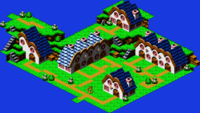
Role playing games (often abbreviated as RPGs) place Mario in a major role. Common gameplay features in RPGs include detailed storylines, a large cast of characters, and the ability to level up. Mario's first appearance in a RPG was in Super Mario RPG: Legend of the Seven Stars. Later, the Paper Mario series and Mario & Luigi series were introduced. Another common feature in RPGs is the ability to use items and equip weapons, armor, clothing, badges, and accessories. These items can be bought at shops or be found in blocks and treasure chests. RPGs often have multiple playable characters with unique stats and abilities. Mario role playing games often contain platforming elements.
The battle system usually involves Mario, his partner(s), and enemies taking it in turns to attack, with action commands to every move. The exception is Super Paper Mario, which is also one part sidescroller. The Paper Mario series differs slightly from the other RPGs because the damage and HP ratio is lower and Mario and his partner will always attack first, and attack power is achieved by getting hammers and boots rather than leveling up. Paper Mario is also split into chapters for which stars Mario must get, and has chapter bosses, with minibosses along the way, while neither really exists in the other RPGs; only bosses, identifiable by different battle theme and higher HP (and often they are characters). Also, in the Mario & Luigi series it is possible (and often necessary) to avoid enemy attacks altogether, where the other RPG's simply have ways to block them and reduce damage (though Super Mario RPG: Legend of the Seven Stars and Paper Mario: The Thousand-Year Door make it possible to completely defend against attacks (excluding magic attacks in Super Mario RPG).
With the exception of Paper Mario, Bowser is never the antagonist in RPG's, though he fights Mario in all of them. Two of them (Super Mario RPG: Legend of the Seven Stars and Super Paper Mario) even have him join Mario's team (though usually his intent is to take over the world himself once the greater threat is out of the way). He is also a playable character in three of the RPGs: Paper Mario: The Thousand-Year Door, Super Paper Mario, and Mario & Luigi: Bowser's Inside Story, though out of these three, only Super Paper Mario actually has him join forces with Mario, even though in Bowser's Inside Story he is fighting against the same enemies as Mario.
Though he only has two small cameos in Super Mario RPG: Legend of the Seven Stars (one of which is non-canon), Luigi has a more major role in four of the RPG's: All three Mario & Luigi games, and Super Paper Mario. Though he does appear in the first two Paper Mario games, Luigi has no role in the plot of the game, though he is out on his own adventures in Paper Mario: The Thousand-Year Door.
RPGs also feature good Goombas, Koopa Troopas, and other creatures who usually appear as enemies.
Party
Party games are multiplayer games usually involving short mini-games. This genre is dominated by the Mario Party series, but the WarioWare series and Itadaki Street DS are also part of it. While most party games involve multiple players, some party games are single player, like certain WarioWare games. Luck is a large factor in party games, but players must also have a certain degree of skill. Party games are rarely played competitively and are usually played casually.
Racing
Racing games are a sub-genre of sports games and involve speedy competitions with other characters. The main objective in racing games is to reach the goal before the other racers and attain first place. Nearly all Mario racing games are part of the Mario Kart series, except for Diddy Kong Racing and Diddy Kong Racing DS. All racing games in the Mario series involve items or power-ups which can do various things like slow down the other racers or speed up the player. Racing games also build on this by providing battle modes in which items are used as weapons. Online racing was introduced with the release of Mario Kart DS and is integrated in every Mario racing game since.
Sports
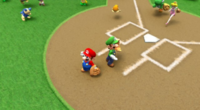
Sports games, like the name implies, are games based on sports. Unlike most conventional sports games, Mario sports games feature items and obstacles. Racing and fighting games are sub-genres of sports games. The genre started with Golf for the Nintendo Entertainment System. This genre of Mario games did not become well known until the release of the Nintendo 64 with games like Mario Tennis 64 and Mario Golf 64. Currently, Mario sports games include golf, tennis, soccer, basketball, baseball, dancing, and Olympic events.
Fighting
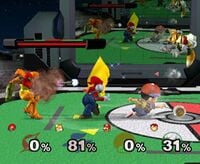
Fighting games pit characters against each other in combat. The objective of fighting games is to knock out the other characters. Fighting games are a sub-genre of sports games. This genre has exclusively been a part of crossover games. The Super Smash Bros. series contains all Mario fighting games. Mario's first appearance in a fighting game was as a referee in Punch-Out!!. His first playable role in a fighting game was in Super Smash Bros., along wth Luigi, Yoshi, and Donkey Kong. Fighting games in the Mario series have significant differences from arcade fighting games. Bowser, Princess Peach, and Dr. Mario later appeared in Super Smash Bros. Melee, and Wario appeared alongside all of them (except Dr. Mario) in Super Smash Bros. Brawl. Instead of depleting the enemy's health, the player must knock the enemy off the screen. Items and obstacle are also available whereas most fighting games do not.
Puzzle
Puzzle games test the player's reflexes and knowledge. The objective in most Mario puzzle games is to clear the screen of various objects similar to Tetris. However, a few Mario puzzle games incorporate different types of gameplay such as picross and mahjong. Games belonging to this genre include the Dr. Mario series, Wario's Woods, and Yoshi's Cookie. Unlike most Mario games, puzzle games do not have items. However, they generally have a large cast of characters.
Edutainment
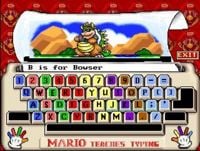
Edutainment games are meant to both educate and entertain the player. Compared to the other genres in the Mario series, the number of edutainment games is relatively small. The purpose of edutainment games is to solve mysteries or simply learn how to do something, like typing or math. Games belonging to this genre are usually developed by a third party company. Due to this, characters may have different personalities. For example, Mario has full dialogue in Mario's Time Machine, despite the fact that he rarely speaks in other games.
Trivia
- Sometimes mainstream games of different genres (sidescroller, 3D platformer, and RPG) are thought to take place in different timelines. However, Mario & Luigi: Partners in Time makes reference to Super Mario Bros., Super Mario World, and Super Mario 64. Also, E. Gadd from Luigi's Mansion appears in Mario & Luigi: Superstar Saga and Mario & Luigi: Partners in Time, and scenes of Mario fighting Iggy in Super Mario World are shown during FLUDD's introduction in Super Mario Sunshine, which, in turn, features E. Gadd's inventions.
- In sidescrollers (as well as a few of the RPG's), Mario and anyone traveling with him can apparently breathe underwater, but in 3D platformer games, he can't.